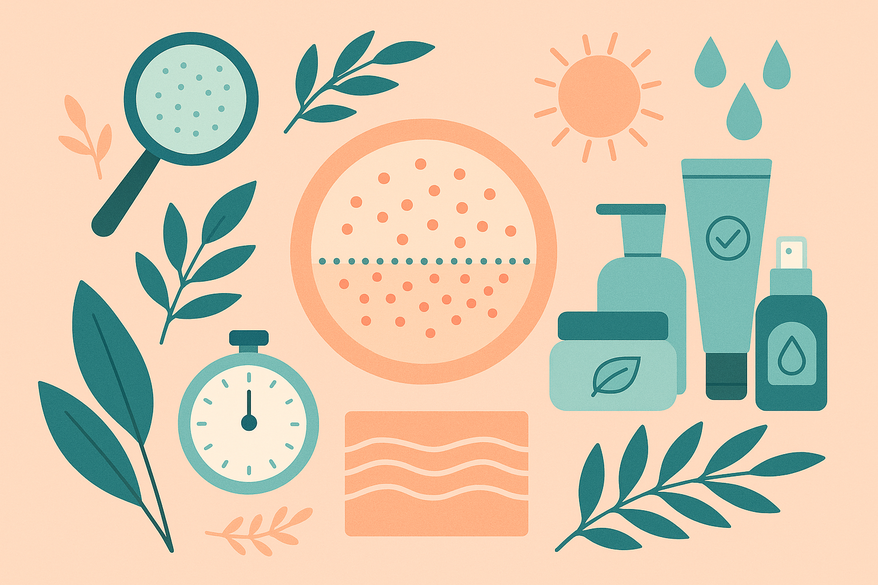Complete Guide to After Rash Detection Skin Care: Steps for Recovery and Prevention
Discover after rash detection skin care routines to speed healing, reduce discomfort, and prevent complications with tips for healthier skin.

Estimated reading time: 8 minutes
Key Takeaways
- Act quickly: Gentle, prompt care soothes inflammation and supports barrier repair.
- Avoid irritants: Eliminate triggers, skip hot water, rough scrubbing, and harsh chemicals.
- Moisturize strategically: Pat skin dry, apply soothing, fragrance-free creams within minutes.
- Know when to seek help: Persistent, spreading, or severe symptoms warrant professional evaluation.
- Practice prevention: Keep a trigger diary, choose hypoallergenic products, and maintain a gentle routine.
Table of Contents
- Understanding Rashes
- Immediate Steps After Rash Detection
- Developing a Skin Care Routine
- When to Seek Professional Help
- Preventative Measures and Long-Term Care
- Conclusion
Understanding Rashes
- What is a rash? A change in skin texture or color—redness, bumps, itching, or swelling that can range from mild to severe.
- Common triggers:
- Allergens: cosmetics, foods, plants, medications.
- Irritants: soaps, detergents, fabrics, environmental particles.
- Infections: viruses (measles), bacteria (impetigo), fungi (athlete’s foot).
- Warning signs: Rapid spread, fever, swelling, blistering, open sores, or severe pain may signal infection or an allergic emergency.
Recognizing the type and severity of your rash is vital to choosing the right care path—from home remedies to professional treatment.
Immediate Steps After Rash Detection
- Gentle cleansing: Rinse with cool or lukewarm water using a fragrance-free, hypoallergenic cleanser to remove irritants without stripping the skin.
- Avoid hot water and scrubbing: Stick to soft fingertips or a clean, soft cloth to prevent further barrier damage.
- No scratching: Keep nails trimmed and consider cotton gloves at night to minimize accidental scratching.
- Identify and eliminate triggers: Remove new products, fabrics, or exposures that may have caused the rash.
- Pat dry: Gently blot with a soft towel, leaving the skin slightly damp for optimal moisture retention.
For an objective second opinion, consider using an AI skin tool like Skin Rash App to receive an instant analysis:

Developing a Skin Care Routine
- Comfort plus barrier support: Focus on soothing active irritation and rebuilding lipids.
- Choose wisely: Use fragrance-free, dye-free, hypoallergenic cleansers and moisturizers. Explore our Top Fragrance-Free Moisturizer Suggestions for a Stronger Skin Barrier.
- Patch-test: Apply a pea-sized amount of any new product to the inner forearm twice daily for seven days before full use.
- Post-bath hydration: Within three minutes of bathing, apply a cream with ceramides or colloidal oatmeal to seal in moisture.
- Delay exfoliants: Skip AHAs, BHAs, and alcohol-based toners until your skin fully recovers.
- OTC relief: Use 1% hydrocortisone or calamine lotion sparingly for short-term itch relief.
- Nighttime occlusion: Apply a non-comedogenic emollient at bedtime to lock in moisture and support overnight repair.
When to Seek Professional Help
- After one week: If there’s no improvement after 5–7 days of gentle care.
- Worsening signs: Rapid spread, severe pain, blistering, or pus demand medical attention.
- Systemic symptoms: Fever, chills, facial swelling, or breathing difficulty require urgent evaluation.
- Prescription treatments: A healthcare provider may recommend topical antibiotics or antifungals based on diagnosis.
Prepare for remote visits with our Online Dermatologist Consultation guide.
Preventative Measures and Long-Term Care
- Maintain a trigger diary: Log new products, foods, fabrics, or activities with any skin reactions. See our guide on how to track progress with photos and notes.
- Hypoallergenic commitment: Consistently choose fragrance- and dye-free body care and laundry products.
- Breathable clothing: Wear loose, cotton garments to reduce friction and moisture buildup.
- Daily hydration: Apply moisturizer twice daily, even rash-free, to maintain barrier strength.
- Family education: Teach loved ones to spot early rash signs and act promptly to prevent escalation.
Conclusion
After rash detection skin care combines immediate soothing, consistent barrier support, trigger management, and timely professional care. This approach not only speeds healing but also builds resilience against future flare-ups.
Next steps:
- Patch-test new products for seven days.
- Cleanse gently and hydrate promptly.
- Avoid hot water, rough scrubs, and harsh formulas.
- Keep a simple trigger diary.
- Use OTC hydrocortisone briefly if needed.
- Consult a dermatologist for persistent or severe rashes.
FAQ
- Can I use my regular exfoliant or toner after a rash?
No. Wait for full healing, then reintroduce exfoliants and toners only after patch testing and confirming no irritation. - How do I patch-test a new product?
Apply a pea-sized amount to your inner forearm twice daily for seven days. If there’s no redness, itching, or burning, it’s generally safe to use more broadly. - What’s the best moisturizer post-rash?
Look for fragrance-free, hypoallergenic creams rich in ceramides, colloidal oatmeal, or glycerin to soothe and restore lipids. - When is a rash an emergency?
Seek immediate care if you experience fever, facial swelling, difficulty breathing, or rapidly spreading blisters, as these may indicate a serious reaction.





